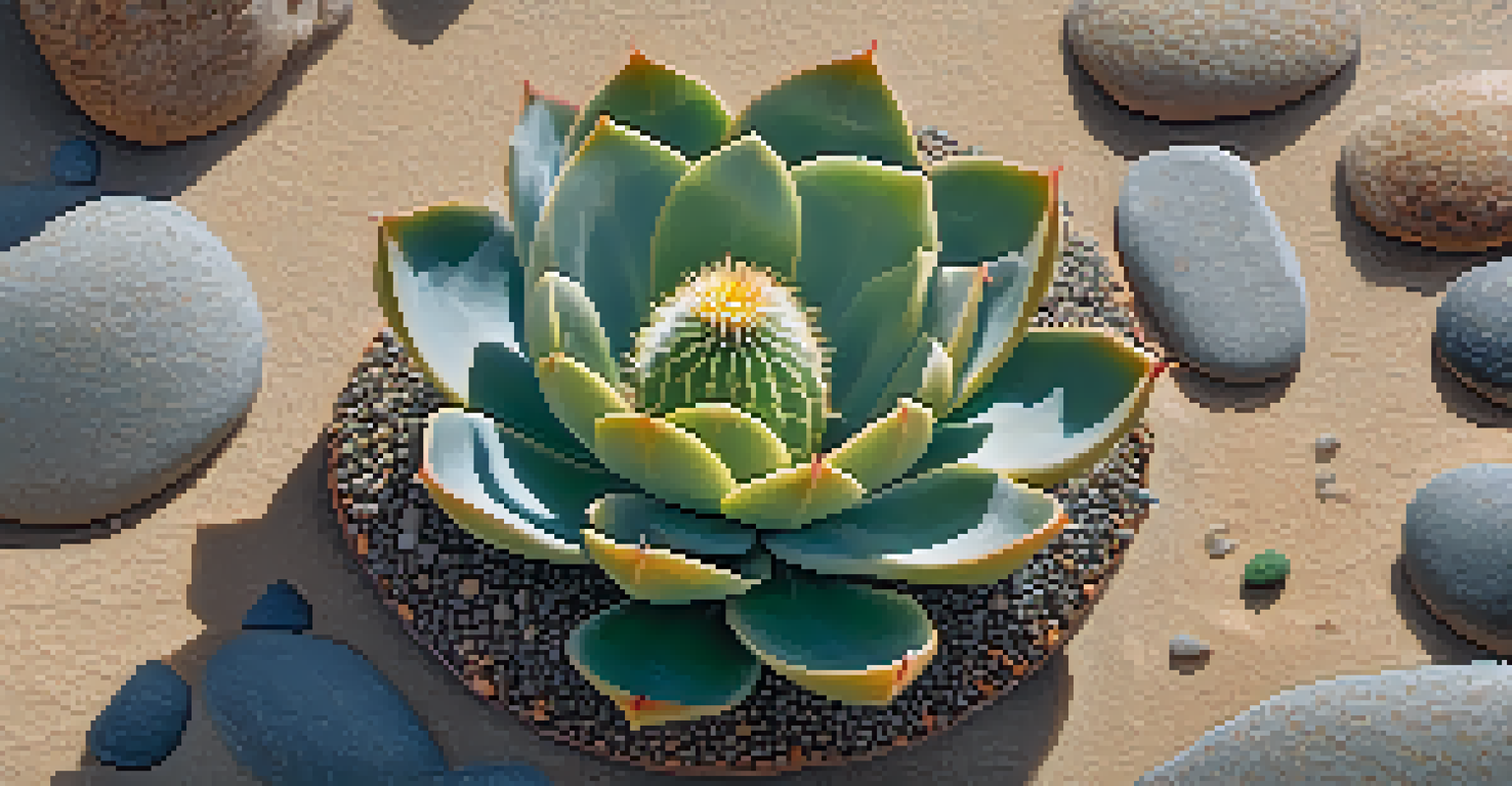Cultural Significance of Peyote and Ecological Sustainability

Understanding Peyote: A Sacred Cactus
Peyote, a small cactus native to Mexico and the Southern United States, holds deep cultural significance, especially among Indigenous peoples. For centuries, it has been used in spiritual ceremonies, offering insights and guidance through its psychoactive properties. The plant's vibrant history is intertwined with the traditions of tribes like the Huichol and the Navajo, who regard it as a bridge to the divine.
The use of peyote is not merely a ritual; it is a profound expression of the relationship between the people and their environment.
The psychoactive compound in peyote, mescaline, is what makes this cactus a key element in ceremonial practices. Participants often describe profound experiences that foster a sense of connection with nature and humanity. This connection is seen as not just a personal journey, but a communal one, reinforcing bonds within the tribe and between generations.
As we explore the layers of peyote's cultural relevance, it’s essential to recognize the respect and responsibility that accompany its use. For many Indigenous communities, peyote is not merely a substance; it’s a sacred gift that requires understanding, reverence, and a commitment to sustainability.
Historical Context: Peyote in Indigenous Cultures
The historical roots of peyote can be traced back thousands of years, where it was used both for its mystical properties and as a food source. The earliest evidence of its use comes from archaeological sites in Mexico, where remnants of the cactus have been found alongside ancient artifacts. This long-standing relationship illustrates how peyote has been integral to the survival and spirituality of various cultures.

Indigenous tribes have developed unique rituals surrounding peyote, often incorporating it into healing practices and communal gatherings. The ceremonies are not just about consumption; they involve prayers, songs, and storytelling, which help to preserve cultural heritage. For many tribes, these rituals offer a sense of identity and continuity in an ever-changing world.
Cultural Significance of Peyote
Peyote is a sacred cactus deeply rooted in Indigenous traditions, serving as a vital element in spiritual ceremonies and communal identity.
However, the arrival of Western colonizers posed significant challenges to the traditional use of peyote. As Indigenous practices faced suppression, the peyote cactus became a symbol of resistance and resilience, with many tribes fighting to maintain their sacred traditions against external pressures.
Contemporary Usage: Peyote Today
In recent years, there has been a resurgence of interest in peyote among Indigenous communities and even outside them. Some individuals seek peyote for its spiritual benefits, while others are drawn to its potential therapeutic applications. This growing interest has sparked discussions about the ethical implications of harvesting and using peyote in modern society.
Cultural appropriation is not just a matter of borrowing; it's about understanding the roots and respecting the traditions from which we draw.
Many Indigenous leaders stress the importance of using peyote responsibly, particularly in a time when the plant is facing ecological threats due to overharvesting and habitat loss. They advocate for a return to traditional practices that emphasize respect for the plant and its environment. This highlights the need for a sustainable approach to ensure that future generations can continue to engage with peyote.
As the dialogue around peyote evolves, it is crucial to consider the voices of Indigenous peoples who have historically held stewardship over the cactus. Their insights can guide contemporary practices, ensuring that the use of peyote remains respectful and sustainable.
Ecological Sustainability: A Critical Concern
The ecological sustainability of peyote is a pressing issue, as increasing demand has led to concerns about its survival in the wild. Overharvesting, driven by both traditional and modern uses, poses a significant threat to peyote populations. Conservation efforts are vital to protect this sacred plant and its ecosystem.
Sustainable harvesting practices are being explored and implemented within various Indigenous communities. These practices include regulated harvesting times, replanting initiatives, and education on the ecological importance of peyote. By fostering a balance between cultural practices and environmental stewardship, communities aim to safeguard the future of peyote.
Sustainability and Conservation Efforts
The increasing demand for peyote has raised concerns about overharvesting, prompting Indigenous communities to advocate for sustainable practices.
Moreover, engaging in conservation efforts can foster a deeper understanding of the interconnectedness of culture and ecology. By prioritizing sustainability, we not only protect peyote but also honor the cultural heritage that it represents. This approach underscores the importance of viewing ecological well-being as a shared responsibility.
Cultural Appropriation: Navigating Modern Use
As interest in peyote has grown outside Indigenous communities, discussions about cultural appropriation have emerged. It’s essential to recognize that peyote is not merely a recreational substance; it carries profound spiritual significance for many tribes. Engaging with peyote outside of its traditional context can risk trivializing its cultural importance.
Cultural appropriation occurs when elements of a marginalized culture are adopted by those in a position of power without understanding or respecting their significance. This can lead to a disconnect between the sacred use of peyote and its commodification in popular culture. It’s crucial for individuals to approach peyote with humility and respect, acknowledging its roots and the communities that hold it sacred.
Education and dialogue are key to navigating these complexities. By learning about the cultural heritage surrounding peyote, individuals can better appreciate its significance and approach its use ethically. This awareness can foster more meaningful connections and support for Indigenous communities.
Legal Status: Peyote in a Changing Landscape
The legal status of peyote varies significantly across different regions, often reflecting societal attitudes towards its use. In the United States, for instance, peyote is protected for religious use by recognized Indigenous groups, but its legality is ambiguous for others. This patchwork of laws can complicate efforts to engage with peyote responsibly and sustainably.
In recent years, there has been a push to recognize the therapeutic potential of peyote, similar to other psychoactive substances. Some advocates argue for a reevaluation of its legal status, suggesting that responsible use could provide mental health benefits. However, any changes in legislation must prioritize the rights and traditions of Indigenous peoples.
Navigating Cultural Appropriation
As interest in peyote grows outside Indigenous communities, it is crucial to approach its use with respect to avoid trivializing its cultural significance.
The ongoing legal debates highlight the need for a balanced approach that respects both cultural heritage and ecological sustainability. As society continues to grapple with these issues, it’s crucial to involve Indigenous voices in discussions about the future of peyote.
The Path Forward: Respect, Education, and Collaboration
Moving forward, it’s essential to foster respect and understanding around peyote and its cultural significance. Education plays a key role in this process, allowing individuals to learn about the rich traditions and practices surrounding this sacred plant. By promoting awareness, we can help counteract misconceptions and encourage responsible engagement with peyote.
Collaboration with Indigenous communities is also vital for ensuring that peyote is used ethically and sustainably. By supporting initiatives that prioritize traditional knowledge and practices, we can contribute to the preservation of both the plant and its cultural heritage. This partnership can empower Indigenous peoples to lead conservation and educational efforts.

Ultimately, the journey toward a respectful relationship with peyote is an ongoing one. By embracing education, collaboration, and sustainability, we can honor the plant’s cultural significance while safeguarding its future for generations to come.